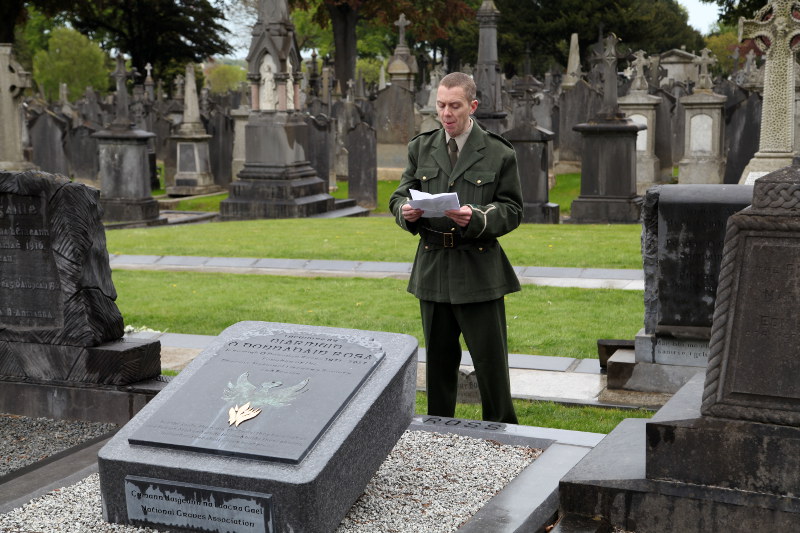Glasnevin Cemetery is vast, complicated, and much of Ireland’s history resides under its earth. 1.2 million people live in Dublin today… but 1.5 million are buried in Glasnevin and because of this, locals refer to it as the city of the dead.
We took a walking tour of the site, which focused primarily on the revolutionary leaders of Ireland. And, I’d endeavour to say that each grave has its own interesting story… on top of the history of the person buried in the ground. I’ll share a few of these below.
Above, an actor is delivering an impassioned eulogy over the grave of O’Donovan Rossa. The man who wrote and delivered the original, Patrick Pearse, was captured after the Easter Rising and executed at Kilmainham Gaol.
Daniel O’Connell
We got a humungous taste of Daniel O’Connell’s history in Ireland and finished the journey at O’Connell’s tomb on May 16, which is a day after the anniversary of O’Connell’s death (which is why the tomb is dressed up in the photo above).
It seems that O’Connell has caught the attention of at least one celebrity. In June 2012, the vault was cleared one day after a mysterious black limo pulled up and its occupant requested a private viewing of the vault. The requester was none other than Yoko Ono, who (we assume) wanted to pay tribute to the man who spent his entire life fighting for Irish Independence in a non-violent way.
It’s said that to touch the casket that holds O’Connell is good luck.
Charles Stewart Parnell
Parnell had a controversial life and at the time of his death was extremely unpopular and penniless. This, however, didn’t stop people from attending his funeral. In fact, so many people came that there was not enough space in the cemetery to deliver the body to the gravesite.
Because officials were afraid of violence, the priest rushed the proceedings and unceremoniously plopped Parnell’s body into the ground… with hundreds of thousands of people who died during the cholera epidemic of 1832. The only grave marker is a giant stone that sits atop the green space.
People do remember his legacy in other ways: after the funeral, as people left the graveyard, they took pieces of ivy from the gates and pinned them to their clothes, and henceforth October 6 (Parnell’s death day) is often referred to as Ivy Day.
Michael Collins
Collins’ grave is one of the most visited graves in Glasnevin and is separated slightly from the “city.” Still, it is within throwing distance of the graves of all of his compadres who died during the Irish War of Independence and the Irish Civil War.
There’s an element of status that goes with being buried close to Collins. The closer you are buried to his grave, the higher your status and in a very “location location location” kind of way, the cost of the grave plot goes up exponentially the closer you get to Collins.
This grave receives a continual stream of flowers… a large number from a French woman named Veronique. She sends flowers to Collins on the anniversary of key IRA and Irish events and she also makes an effort to visit the grave a few times a year.
Kitty Kiernan
Kitty Kiernan was Michael Collins’ fiance at the time of his death. She survived the Irish Civil War and went on to marry Felix Cronin, the “Q” of the Irish Army. Their second child was named after Michael Collins.
Her dying request in 1945 was to be buried as close as possible to Michael. Her grave is within throwing distance and also near many of the other revolutionary leaders who fought during the Irish War of Independence.
Eamon de Valera
In life, de Valera was a very non-assuming and humble person. As such, in death, he requested that his family not adorn his grave with flowers or chachkies. That said, de Valera’s funeral in 1975 was such a huge event that Glasnevin had to install a telephone to handle requests and accommodate the needs of the world press.
We were told that de Valera’s grave elicits the most passionate of reactions from people during tours. Some will kiss it or fall weeping in front of the grave; while others will walk away and refuse to go near it or listen to stories about de Valera’s life.
Our tour guide told us of a recent instance where, when explaining the various reactions, one man stepped forward, walked to the grave, spit on it, and walked away after stating, “there’s my reaction.”
The gallery contains various images from around the “city of the dead.”
